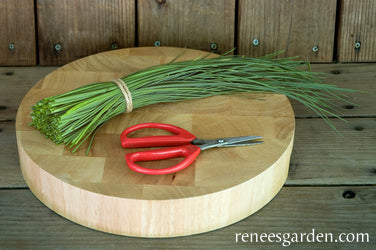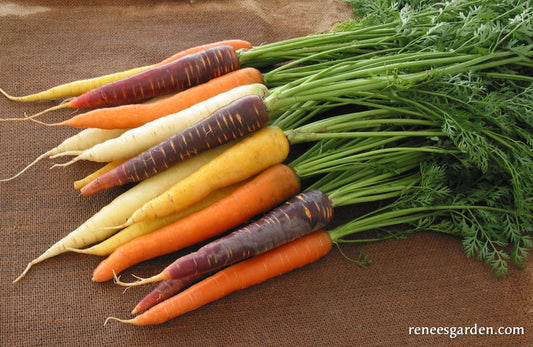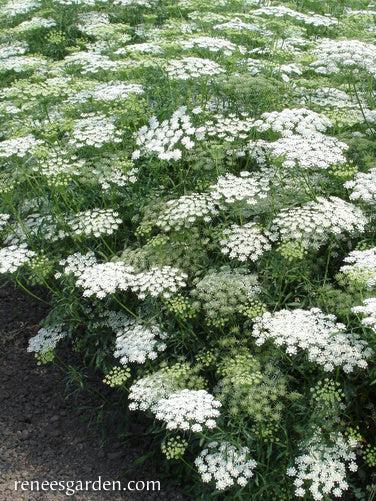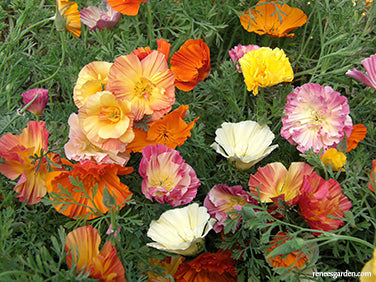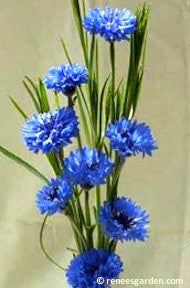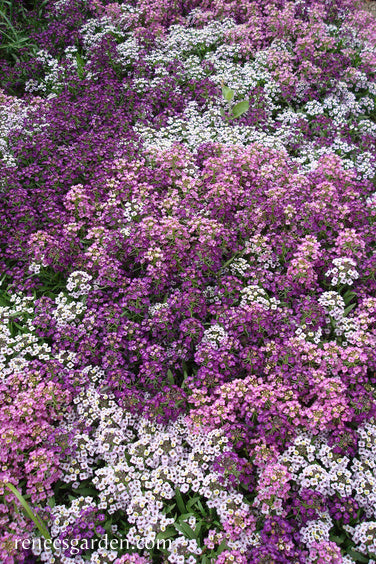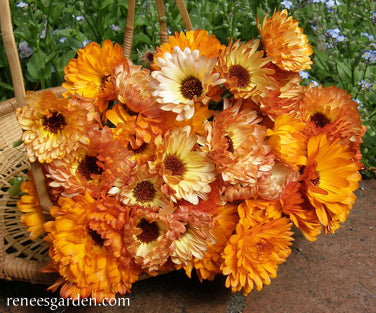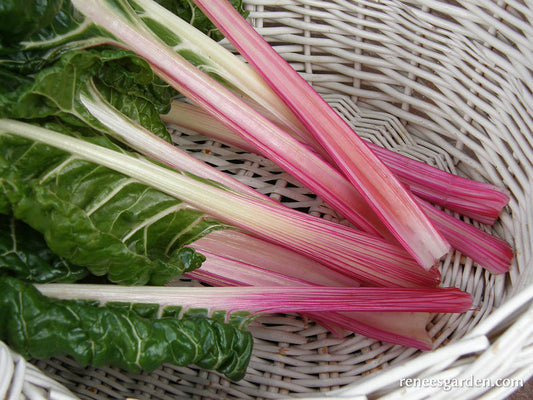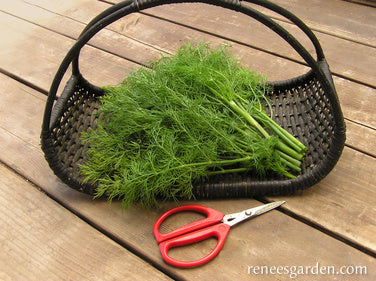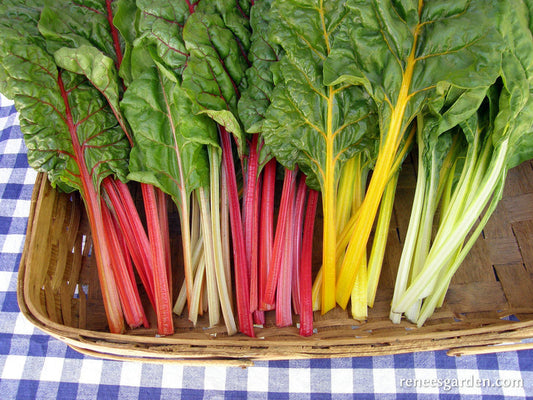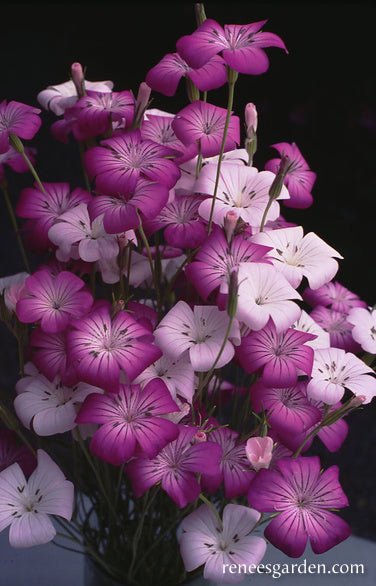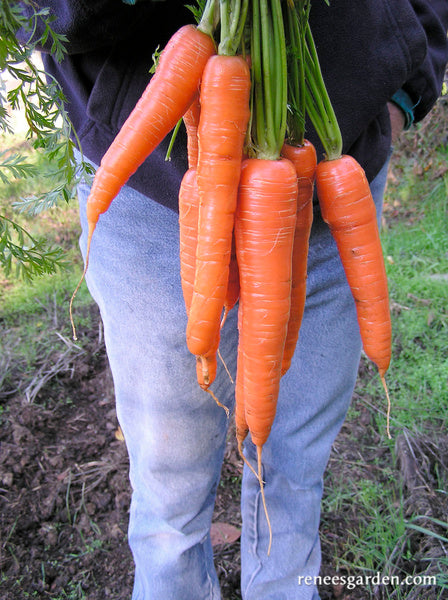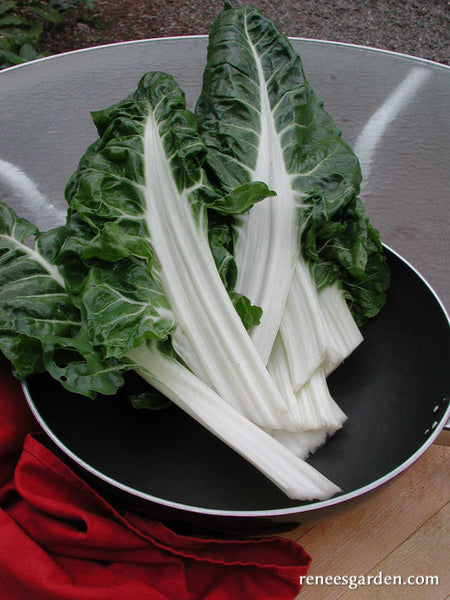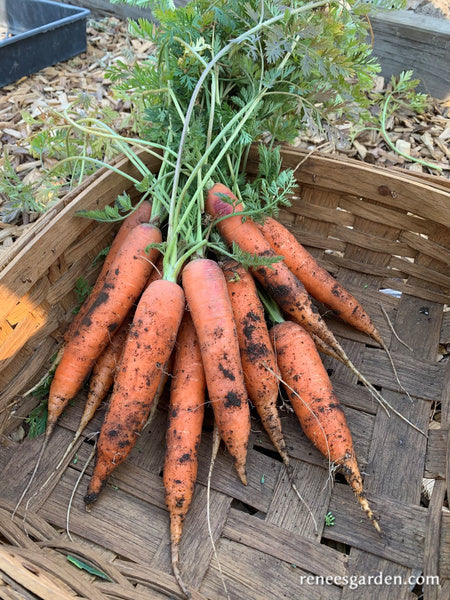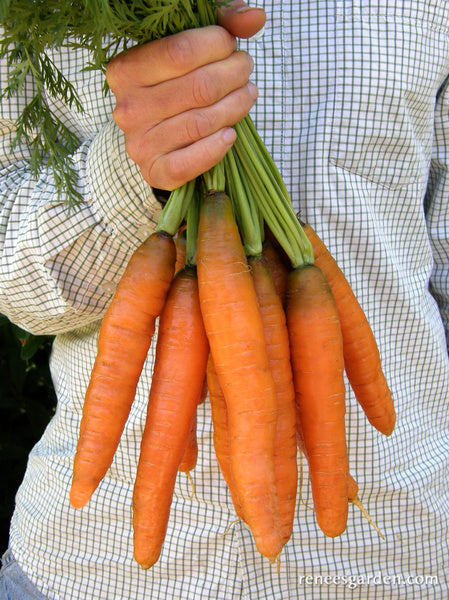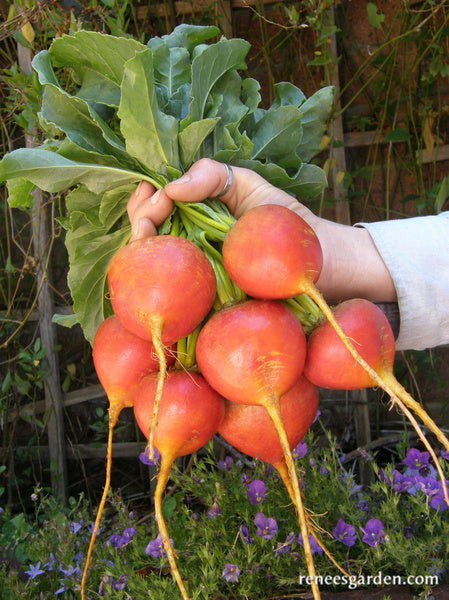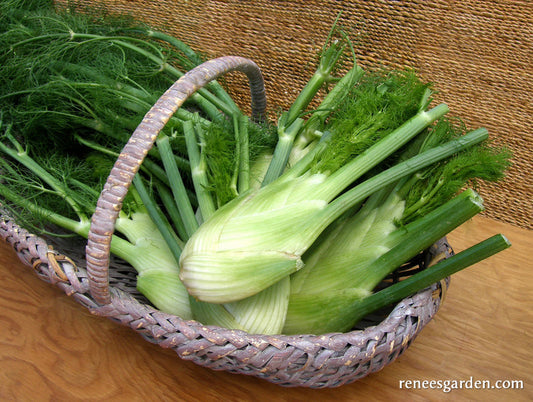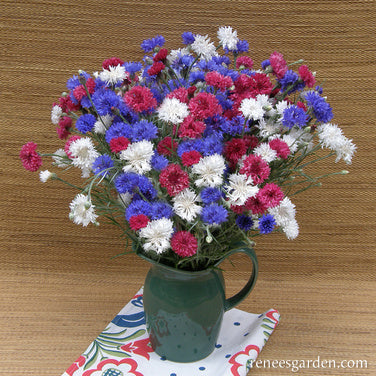Seeds For Fall Gardens
Seeds For Fall Gardens
In cold winter areas: plant mid-summer. In mild winter areas: plant mid-summer/early fall.
-
Heirloom Cilantro
EASIEST TO START OUTDOORS
In early spring, sow Cilantro seed directly into well-drained fertile soil 1 to 2 inches apart in rows 8 inches apart in full sun. Cover 1/2 inch deep and firm soil over seeds. Keep seed bed evenly moist as seedlings emerge over 10 to 20 days. Make new sowings every few weeks until mid summer for continuous harvests of fresh leaves.
THIN OR TRANSPLANT
Cilantro doesn’t transplant well; we advise direct garden sowing. Thin seedlings 3 to 4 inches apart before plants get crowded.
GROWING NOTES
Cilantro plants flower, then set seed quickly as plants mature. Lushest, leafy growth takes place in cooler weather; plant early and throughout cool spring weather and sow again in fall, particularly in mild winter areas. To have a constant supply of fresh leaves, sow every 2 to 3 weeks through early summer. Keep cilantro at its leafy stage longer by keeping plants well watered and being careful to thin seedlings early. Let some of the lacy flowers form to attract beneficial insects and pollinating bees. The fragrant round seeds are called coriander, an aromatic spice used in baking.
Regular price $4.89Sale price $4.89Unit price / per -
Heirloom Culinary Chives
PERENNIAL
Spring/summer/fall harvest
Frost hardyTO PLANT OUTDOORS
In cool spring weather, sow clusters of 7 to 10 seeds about 8 to 10 inches apart in well-worked, fertile soil in sun or part shade. Cover 1/4 inch deep and press soil firmly over seeds. Keep evenly moist as seeds germinate slowly over several weeks. Emerging clusters of seedlings have very slender grass-like leaves that mature into mounds.
TO START EARLY INDOORS
In early spring, sow 7 to 10 seeds in individual containers of starting mix and cover 1/4 inch deep. Keep evenly moist as seedlings slowly emerge and provide a good light source until ready to plant outdoors. Transplant clusters of seedlings when 2 to 3 inches tall after gradually acclimating plants to outdoor conditions.
THIN OR TRANSPLANT
Space clusters of 7 to 10 seedlings 8 to 10 inches apart.
GROWING NOTES
Chives bear lilac-pink clover-like flowers in late spring and summer. After bloom finishes, cut entire plant back to 2 inches to encourage regrowth of tender new leaves. Given plenty of moisture and a location out of fierce sun, chives are hardy, self-sufficient plants. lilac-pink clover-like flowers in late spring and summer. After bloom finishes, cut entire plant back to 2 inches to encourage regrowth of tender new leaves. Given plenty of moisture and a location out of fierce sun, chives are hardy, self sufficient plants.Regular price $4.89Sale price $4.89Unit price / per -
Rainbow Carrots Harlequin Mix
START SEEDS OUTDOORS
In spring once danger of hard frost is past, sow seeds in full sun in finely worked, fertile soil. Sow 1/4 inch deep and 1/2 inch apart in rows 8 inches apart, or broadcast thinly in beds and cover lightly. Keep seedbed evenly moist as carrots can be slow to germinate, emerging over 10 to 20 days. If first sowing comes up unevenly, replant right away as seedlings catch up quickly. Be sure to thin young carrots several times so seedlings are about 2 inches apart and have the room they need to size up.
GROWING NOTES
Carrots like well-worked soil and need consistent moisture to grow well. If your soil tends to dry out, cover seedbed with floating row cover to help retain moisture during the germination period and water right through it. Keep carrots well watered and thinned. For a late season crop, sow again 3 months before first expected frost.
HARVEST AND USE
For best sweet flavor, let these pretty, different colored carrots size up and fully mature before harvesting. Enjoy these extra healthy carrots raw as snacks or grated into salads for great eye appeal. Sauté or steam just until tender crisp and serve with a little sweet butter and your favorite fresh chopped herb. Carrots go well with dill, tarragon, chives, cilantro or mint.
Regular price $4.69Sale price $4.69Unit price / per -
Butterfly Flowers White Bishop's Lace
ANNUAL
Spring/summer/fall bloom
Can handle light frostBEST TO START DIRECTLY IN THE GARDEN
Sow seed thinly into a finely textured garden bed in full sun as early in spring as ground can be worked. Cover 1/4 inch deep and keep soil moist. Weed and water young seedlings carefully and thin before they get too crowded.
TO START EARLY INDOORS
Start seed indoors 6 weeks before last spring frost date. Sow seeds as thinly as possible in a container or individual pots of seed starting mix. Cover very lightly, keep evenly moist and provide a strong light source until seedlings are ready to plant outdoors. Transplant carefully to avoid disturbing roots. Thin or transplant seedlings 8 to 10 inches apart when large enough to handle.
GROWING NOTES
Bishop’s Lace grows easily in most garden conditions. Make several sowings a few weeks apart through late spring for a succession of bloom. In mild winter climates, sow again in late fall for earliest spring displays. Use Bishop’s Lace as a delicate filler flower for adding texture and dainty substance to every bouquet.
Regular price $2.99Sale price $2.99Unit price / per -
California Poppies Dancing Ballerinas
ANNUAL
Spring/Summer/Fall bloom
Can handle light frostBEST TO START DIRECTLY IN THE GARDEN
Sow seeds directly into a finely textured, well-drained garden bed in full sun as early in spring as the ground can be worked. Plant as early as possible in spring, as poppies can handle light frost and bloom best and longest when plants get a good start in cool weather. In mild winter climates, Poppies can also be sown in late fall to overwinter for spring bloom. Except in very poor soil, these California poppies will grow and flower readily with no added fertilizer. Space seeds several inches apart, cover no more than 1/4 inch deep, and firm soil gently. Keep soil moist as seedlings emerge. If seedlings come up very thickly, thin poppies early but delay final thinning until seedlings are well established in spring. Space seedlings, 4-6 inches apart as plants need room to grow and bloom.
GROWING NOTES
When mature, poppy plants can handle dry conditions, but they will always bloom brighter and longer if regularly watered and are kept well weeded. Poppies are pretty cut flowers if brought indoors just as buds begin to open. At season’s end, allow spent flowers to form pods and drop seed if you want poppies to self-sow for next year's spring flowers.Regular price $3.99Sale price $3.99Unit price / per -
Heirloom Cornflowers Blue Boy
HARDY ANNUAL
Spring/summer bloom
Can handle light frostTO START OUTDOORS
Sow seeds in a finely textured garden bed in full sun as soon as soil can be worked. In mild winter areas, where the ground doesn’t freeze, plant in fall for next spring’s bloom. Space seeds 1 to 2 inches apart and cover 1/2 inch deep. Keep seed bed moist until seedlings emerge in 7 to 10 days. Weed and water carefully. Thin seedlings to 6 to 8 inches apart.
TO START EARLY INDOORS
Sow seeds 1 to 2 inches apart in a container of seed starting mix, 2 or 3 weeks before last expected frost. Cover 1/2 inch deep, keep moist and provide a good light source until seedlings are transplanted outside. Plant 6 to 8 inches apart into fertile garden soil in full sun when plants are 3 to 4 inches tall. Seedlings grow quickly; plant out before the roots get crowded.
GROWING NOTES
In mild winter areas the best cornflowers (aka Bachelor Buttons) result from seeds sown in fall to bloom the next spring. In cold winter areas where ground freezes, plant in early spring to get sturdy plants that will flower for many weeks if faded blossoms are removed.
Regular price $2.99Sale price $2.99Unit price / per -
Honey-Scented Alyssum Summer Romance
HARDY ANNUAL
Spring/summer bloom
Can handle frostEASIEST TO PLANT DIRECTLY IN THE GARDEN
Plant in early spring in well-worked soil in a sunny spot. Sow 1/2 inch apart and barely cover. Keep evenly moist while awaiting germination. Seedlings will create a carpet of fine textured leaves, followed by a blanket of soft, airy flowers.
TO START EARLY INDOORS
Sow indoors 3 to 4 weeks before last frost in a large seed flat. Broadcast seeds 1/2 to 1 inch apart. To transplant, separate clusters of 4 to 5 seedlings and plant each cluster 3 to 5 inches apart.
GROWING NOTES
Given ordinary garden soil and even moisture, alyssum grows easily and blooms profusely just 6 to 8 weeks from sowing. Plants stay compact and don't get rangy. After the first flush of intense flowering is over, cut plants back halfway to re-bloom abundantly. In mild winter areas, sow alyssum in the fall around bulbs, in containers or to cover bare areas. Plants overwinter to bloom all spring in a pretty carpet of pastel shades.
Regular price $3.69Sale price $3.69Unit price / per -
Forget-Me-Nots Azure Bluebirds
HARDY ANNUAL
Spring/summer bloom
Can handle frostEASIEST TO PLANT DIRECTLY IN THE GARDEN
Sow seeds directly into a finely textured, well-drained garden bed as early in spring as the ground can be worked, or in mid-summer where winters have only light frosts. Space seeds 2 to 3 inches apart and cover 1/4 inch deep. Keep soil moist as seedlings emerge in 7 to 14 days. Weed young seedlings carefully and thin before they get too crowded for best displays of flowers.
THIN OR TRANSPLANT
Extra thinned seedlings can easily be transplanted elsewhere in groups of 5-7 plants.
GROWING NOTES
In mild winter climates plants sown in midsummer (late July to mid August) develop throughout late summer and early autumn to flower abundantly the following spring.
In cold winter areas very early spring planting is fine. Forget-Me-Nots will naturalize easily. Pull out plants when bloom is finished and shake seed out if you want them to naturalize on their own.
Regular price $2.99Sale price $2.99Unit price / per -
Butterfly Flowers Flashback Calendula
HARDY ANNUAL
Spring/fall bloom
Takes light frostTO START OUTDOORS
Calendulas bloom best in cool weather, so plant in early spring. Sow seeds 1 inch apart in well-drained soil in full sun. Cover 1/2 inch deep, firm soil and keep seed bed moist. Germination takes 1 to 2 weeks. After seedlings are well established, thin or transplant 8 inches apart to allow for good air circulation and discourage mildew. Calendulas can be sown again in midsummer for fall bloom.
TO START EARLY INDOORS
In early spring, sow seeds 1 inch apart in a container of seed starting mix and cover 1/2 inch deep. Keep evenly moist as seedlings emerge and provide a good light source until ready to plant outdoors. Transplant when seedlings are about 2 to 3 inches tall after gradually acclimating plants to outdoor conditions. Thin or transplant seedlings 8 inches apart for best performance.
GROWING NOTES
Plant when weather is cool to get sturdy plants that bloom for many weeks if faded flowers are removed. Grow this quick-flowering, easy annual along with snapdragons, cornflowers and pansies for late spring bloom. In mild climates, sow again in late summer for winter or very early spring flowers.
Regular price $2.99Sale price $2.99Unit price / per -
Gourmet Chard Peppermint Stick
START SEEDS INDOORS
In early spring, when danger of frost is over, sow seeds in well-worked, fertile soil in full sun. Space seeds 1 inch apart and cover 1/2 inch deep in rows 10 inches apart, or broadcast thinly for bed planting. Firm soil well over these irregularly shaped seeds to ensure good germination. If first sowing germinates unevenly, plant more seed as the seedlings catch up quickly. When large enough to handle, thin seedlings to 8 to 10 inches apart so these large plants have room to grow and mature. Transplant extras or enjoy young thinnings as early greens and salads.
GROWING NOTES
Chard grows well in a wide range of conditions and can take some light frost. In mild winter areas, it can be grown year round. Give seedlings enough room, because chard grows into large vase-shaped plants 2 feet tall.
HARVEST AND USE
Begin harvesting when plants are well established and have at least 6 to 8 leaves. Both stalks and leaves make great eating. Chop and steam or sauté with garlic and olive oil. Use like spinach in lasagna or minestrone soup. Try tasty chard leaves stuffed and poached in broth with a dash of olive oil and fresh lemon.
Regular price $3.69Sale price $3.69Unit price / per -
Kitchen Herbs Dukat Leafy Dill
ANNUAL
Spring/summer/fall harvest
Can handle light frostsEASIEST TO PLANT OUTDOORS
In early spring, sow dill seed directly into well-drained garden soil 1 to 2 inches apart in rows 6 inches apart in full sun and cover seeds 1/4 inch deep. Make small sowings every few weeks to have successive harvests of fresh leaves. Keep seed bed evenly moist while awaiting germination in 7 to 14 days.
TO START INDOORS
Sow dill seed thinly in individual pots of seed starting mix. Cover 1/4 inch deep and keep moist as seedlings emerge in 7 to 14 days. Provide a good light source. Transplant when seedlings are about 2 inches tall after gradually acclimating to outdoor conditions. Don’t let seedlings get crowded before planting outside.
THIN OR TRANSPLANT
Space groups of 2 or 3 seedlings about 4 inches apart when seedlings are large enough to handle.
GROWING NOTES
Keep plants well watered and thinned; crowded seedlings won’t make the lush growth desired for fresh leaf harvests and will form seed heads too early. Make several successive sowings for plenty of leafy dill fronds followed by seed heads to use for pickles and other savory dishes.Regular price $2.99Sale price $2.99Unit price / per -
Heirloom Dill Leafy Diana
EASIEST TO PLANT OUTDOORS
In early spring, sow dill seed directly into well-drained garden soil 1 to 2 inches apart in rows 6 inches apart in full sun and cover seeds 1/4 inch deep. Make small sowings every few weeks to have successive harvests of fresh leaves. Keep seed bed evenly moist while awaiting germination in 7 to 14 days.
TO START INDOORS
Sow dill seed thinly in individual pots of seed starting mix. Cover 1/4 inch deep and keep moist as seedlings emerge in 7 to 14 days. Provide a good light source. Transplant when seedlings are about 2 inches tall after gradually acclimating to outdoor conditions. Don’t let seedlings get crowded before planting outside.
THIN OR TRANSPLANT
Space groups of 2 or 3 seedlings about 4 inches apart when seedlings are large enough to handle.
GROWING NOTES
Keep plants well watered and thinned; crowded seedlings won’t make the lush growth desired for fresh leaf harvests and will form seed heads too early. Make several successive sowings for plenty of leafy dill fronds followed by seed heads to use for pickles and other savory dishes.
Regular price $4.89Sale price $4.89Unit price / per -
Rainbow Chard Bright Lights
START SEEDS OUTDOORS
In early spring when danger of hard frost is over, sow seeds in well-worked, fertile soil in full sun. Sow seeds 1/2 inch deep and 1 inch apart in rows 10 inches apart, or broadcast thinly for bed planting. Firm soil well over these irregularly shaped seeds to ensure good germination. If first sowing germinates unevenly, plant more seed in the rows as seedlings catch up quickly. Thin to select colors beginning when seedlings are large enough to handle, using thinnings as early greens and salads. Final spacing should be 10 to 12 inches apart so chard plants have room to mature.
GROWING NOTES
Chard grows well in a wide range of conditions and can take some frost. In mild winter areas, it can be grown year round. Thin seedlings well as chard grows into large vase-shaped plants 2 feet tall.
HARVEST AND USE
Begin harvesting when plants are well established and have 6 to 8 stalks. Both the crunchy succulent stalks and leaves make great eating. Chop and steam or sauté greens with garlic and olive oil or season with fresh lemon juice or balsamic vinegar. Use like spinach in lasagna or minestrone soup. Try tasty chard leaves stuffed and poached in broth with a dash of olive oil and fresh lemon.
Regular price $4.99Sale price $4.99Unit price / per -
Agrostemma Purple Queen and Pink Contessa
HARDY ANNUAL
Spring/summer bloom
Frost HardyBEST TO PLANT DIRECTLY IN THE GARDEN
Mild Winter Climates: Sow seeds either in early spring or in late fall to germinate and form deep roots for a long spring bloom.
Cold Winter Climates: Sow seed as early in spring as soil can be worked. Space seeds 1 to 2 inches apart in well-drained soil in full sun or partial shade in hot areas. Cover 1/4 inch deep, firm soil and keep seed bed moist. Be patient; germination takes 14 to 21 days. After seedlings are well established and 2 or 3 inches tall, thin or transplant 8 to 10 inches apart. Keep plants well watered and weeded for best performance.
TO START EARLY INDOORS
Sow seeds 1 inch apart in seed-starting mix, 4 to 6 weeks before last expected frost. Cover 1/4 inch deep, keep moist and provide a good light source until ready to plant outside when the weather warms up. Thin or transplant seedlings 8 to 10 inches apart when large enough to handle.
GROWING NOTES
Spring Sowing: plant seed as early as soil can be worked to get sturdy plants that will provide many weeks of graceful bloom.
Fall Sowing: wait until soil has cooled in late fall. Extend the blooming season by cutting faded flowers before seed pods develop.
Regular price $3.39Sale price $3.39Unit price / per -
Long Sweet Carrots King Midas
START SEEDS OUTDOORS
In spring once danger of hard frost is past, sow seeds in full sun in finely worked, fertile soil. Sow 1/4 inch deep and 1/2 inch apart in rows 8 inches apart, or broadcast thinly in beds and cover lightly. Keep seed bed evenly moist as carrots can be slow to germinate, emerging over 10 to 21 days. If first sowing comes up unevenly, replant right away as seedlings catch up quickly. Thin young carrots several times so seedlings are 2 to 3 inches apart and have room to size up.
GROWING NOTES
Carrots like well-worked soil and need consistent moisture to grow well. If your soil tends to dry out, cover seedbed with floating row covers to help retain moisture during the germination period. Keep carrots well weeded throughout the growing season. Plant again 3 months before first expected fall frost for a late crop.
HARVEST AND USE
Let carrots size up to at least 6 to 8 inches long before pulling for best sweet flavor. Eat them raw, sliced up as tasty fresh snacks, sautéed, steamed or braised. Set off their flavor with fresh lemon or orange juice and a sprinkling of minced herbs like fresh mint or thyme or glaze with a little honey, ginger or cinnamon. Wonderful in colorful stir-fries all season long.
Regular price $2.99Sale price $2.99Unit price / per -
Heirloom Flowers Mountain Garland Clarkia
HARDY ANNUAL
Summer/Fall bloom
Can handle light frostEASIEST TO START DIRECTLY IN THE GARDEN
As early in spring as ground can be worked, sow seeds 1 inch apart into a finely textured garden bed in full sun. In climates where the ground doesn’t freeze, sow seed in late fall for bloom the following spring. Cover very lightly, about 1/8 inch deep and keep soil moist as seedlings emerge. Weed and water carefully and thin before they get too crowded.
TO START EARLY INDOORS
Start seed indoors 4 weeks before last spring frost date. Sow seeds an inch apart in a container of seed starting mix. Cover very lightly, keep evenly moist and provide a strong light source until seedlings are ready to plant outdoors. Plant in the garden when seedlings are large enough to handle. Thin or transplant seedlings 6 inches apart.
GROWING NOTES
Clarkia grows well in a wide range of conditions, but if you are in a very hot, humid climate, planting in a spot with afternoon shade will extend flowering. These carefree wildflowers thrive in well-drained soil. Plant in mixed borders or anywhere you want an informal effect of vibrant color and armfuls of entrancing flowers to bring indoors.
Regular price $2.99Sale price $2.99Unit price / per -
Heirloom Chard Italian Silver Rib
START SEEDS OUTDOORS
In early spring when danger of hard frost is over, sow seeds in well-worked, fertile soil in full sun. Sow seeds 1/2 inch deep and 2 inches apart in rows 10 inches apart, or broadcast very thinly for bed planting. Firm soil well over these irregularly shaped seeds to ensure good germination. If first sowing germinates unevenly, plant more seed in the rows as seedlings catch up quickly. Thin when seedlings are large enough to handle, using thinnings as early greens. Final spacing should be 12 to 18 inches apart so chard plants have room to mature.
GROWING NOTES
Chard grows well in a wide range of conditions and can take some frost. In mild winter areas, it can be grown year round. Thin seedlings well as chard grows into large vase-shaped plants 2 feet tall.
HARVEST AND USE
Begin harvesting when plants are well established and have 6 to 8 stalks. Both the crunchy succulent stalks and leaves make great eating. Chop and sauté chard with garlic and olive oil or pair with sautéed mushrooms and onions. Try steamed and topped with a sprinkle of vinegar or fresh lemon juice. Use like spinach in lasagna or minestrone soup.
Regular price $2.99Sale price $2.99Unit price / per -
Crispy French Carrots Bolero Nantes
START SEEDS OUTDOORS
In spring once danger of hard frost is past, sow seeds in full sun in finely-worked, fertile soil. Sow 1/4 inch deep and 1/2 inch apart in rows 8 inches apart, or broadcast thinly in beds and cover lightly. Keep seed bed evenly moist as carrots can be slow to germinate, emerging over 10 to 21 days. If first sowing comes up unevenly, replant right away as seedlings catch up quickly. Thin young carrots several times so seedlings are 2 to 3 inches apart and have room to size up.
GROWING NOTES
Carrots like well-worked soil and need consistent moisture to grow well. If your soil dries out fast, cover seedbed with floating row covers to help retain moisture during the germination period. Keep carrots well weeded throughout the growing season. Plant again 3 months before first expected fall frost for a late crop.
HARVEST AND USE
Let carrots color up to deep orange before harvesting for best sweet flavor. Eat fresh, juice, or lightly steam. Set off their flavor with fresh lemon or orange juice and a sprinkling of minced herbs. Or glaze with a little honey and ginger or cinnamon. Fresh mint leaves are a tasty, pretty garnish for fresh garden carrots.
Regular price $3.99Sale price $3.99Unit price / per -
Nantes Carrots Yaya
START SEEDS OUTDOORS
In spring once danger of hard frost is past, sow seeds in full sun in finely worked, fertile soil. Sow 1/4 inch deep and 1/2 inch apart in rows 8 inches apart, or broadcast thinly in beds and cover lightly. Keep seedbed evenly moist as carrots can be slow to germinate, emerging over 10 to 20 days. If first sowing comes up unevenly, replant right away as seedlings catch up quickly. Be sure to thin young carrots several times so seedlings are about 2 inches apart and have room to size up.
GROWING NOTES
Carrots like well-worked soil and need consistent moisture to grow well. If your soil tends to dry out, cover seedbed with floating row cover or burlap to help retain moisture during the germination period and water right through it. Keep carrots well watered and thinned. For a late season crop, sow again 3 months before first expected frost.
HARVEST AND USE
Let young carrots size up and color fully to orange before harvesting for best flavor. Sauté or steam just until tender crisp and serve with a squeeze of fresh lemon or lime juice, sweet butter and fresh dill; or try buttered and glazed with a little maple syrup or honey.
Regular price $4.89Sale price $4.89Unit price / per -
Signature Salads Crispy Winter Greens
START SEEDS OUTDOORS
At midsummer, or early fall in mild climates, sow seeds in a sunny garden bed 1/4 inch deep and 1 to 2 inches apart in rows 12 inches apart. Or, if it is still over 80°F (27°C) at sowing time, sow seeds in containers in a spot out of direct sun, but with bright light all day. Tend carefully and keep evenly moist. When seedlings are a few inches tall with several sets of leaves, transplant into the garden a foot apart. Gradually thin directly sown seedlings to stand 1 foot apart to allow heads room to mature.
GROWING NOTES
Savor earliest thinnings in fall salads. Cool weather will bring vigorous growth. These tasty greens tolerate cold weather and light frosts well but require consistent moisture. Weed, water and thin carefully and feed monthly for best quality salad heads.
HARVEST AND USE
Radicchio is best harvested when red heads have formed inside the outer green “wrapper” leaves. Pick entire heavy rosettes of escarole and curly endive. Cut up and enjoy these hearty salads with either simple vinaigrettes or rich, creamy dressings. Try tossed with cooked chicken, meat or cubed cheese and olives for delicious whole meal salads. Add toasted nuts and cubed apples or pears for a delicious flavor contrast.
Regular price $3.69Sale price $3.69Unit price / per -
Gourmet Beets Golden
START SEEDS DIRECTLY OUTDOORS
In early spring, when danger of hard frost is over, sow seeds in well-worked, fertile soil in full sun. Space seeds 1 inch apart in rows 8 to 10 inches apart, or broadcast evenly for bed planting. Firming soil well over these irregularly shaped seeds will ensure best germination. If first sowing comes up unevenly, sow more seeds as seedlings will catch up fast. When large enough, carefully thin seedlings to 3 to 4 inches apart so growing beets have room to size up.
GROWING NOTES
For best quality, tender roots, sow seeds before midsummer heat and again in late summer to early fall—in cold climates, allow at least 10 weeks before fall frosts. Keep soil evenly moist throughout the season. Be sure to thin seedlings several times when plants are small, as beets grow best if given enough room.
HARVEST AND USE
After thinning seedlings, use tender young tops for nutritious, flavorful steamed greens. Harvest baby beets at 1 to 2 inches in diameter, or let roots grow as large as desired. Garden fresh beets cook quickly. They are delicious steamed, boiled or baked whole in their skins like potatoes, then peeled for wonderful color and sweet concentrated flavor. Golden color does not “bleed” like red beets.
Regular price $3.99Sale price $3.99Unit price / per -
Triple-Curled Kale Dutch Darkibor
TO START DIRECTLY IN THE GARDEN
As soon as ground can be worked in spring, prepare a well-drained, fertile garden bed in full sun. Sow seeds 2 inches apart in rows 12 to 18 inches apart. Cover 1/2 inch deep and keep soil evenly moist to ensure good germination. Sow again in late summer for another cold-hardy crop.
TO START INDOORS
Sow seeds in a container of seed starting mix 2 inches apart and cover 1/2 inch deep. Keep moist and provide a strong light source until seedlings are 3 to 4 inches tall then plant outdoors. Space 10 to 12 inches apart so plants have room to mature.
GROWING NOTES
Kale tastes best in cool weather so sow spring crops early. A crop sown in late summer will yield through fall and winter except in the coldest climates. Frost actually enhances kale leaves’ color, flavor and sweetness. Mulch to retain moisture in summer and before the ground freezes to protect the roots of fall crops.
HARVEST AND USE
Begin harvesting outer leaves when plants have 6 to 8 leaves. Vitamin-rich kale is delicious in hearty winter soups, stews and sautés; or braise the beautiful leaves with garlic and olive oil in traditional Mediterranean style. Pull and discard once plants begin to bloom since the leaves of flowering stalks get tough and bitter.
Regular price $3.99Sale price $3.99Unit price / per -
Heirloom Bulbing Fennel Romanesco
STARTING SEEDLINGS
In early spring when danger of hard frost is over, sow seeds in well-worked, fertile soil in full sun. Space seeds 4 inches apart in rows 12 inches apart and cover seed 1/2 inch deep. Carefully thin when seedlings are large enough to handle to stand 10 to 12 inches apart so bulbs have room to grow and mature. Or start seeds indoors in a container of seed starting mix. Keep moist and provide a strong light source until seedlings are 3 or 4 inches tall and ready to transplant as above.
GROWING NOTES
For tender, best quality bulbs, fennel needs rich soil and cool growing weather, so sow seeds as early as the ground can be worked and again in midsummer for fall harvesting. Be sure seedlings are thinned or transplanted 10 to 12 inches apart. Keep plants evenly moist throughout the growing season – mulching is a good strategy. Fennel is a heavy feeder, so fertilize every 2 to 3 weeks with a high nitrogen fertilizer such as fish emulsion.
HARVEST AND USE
When bulbs are full and plump, cut them off at soil level. Trim the feathery leaves down to the solid base. Slice the crispy bulbs and add to salads, or eat with dips, or grill or sauté. The leafy tops are a great seasoning for seafood, especially salmon. Fennel’s flavor is like sweet anise/ celery that becomes deeper and richer with cooking.
Regular price $4.89Sale price $4.89Unit price / per -
Heirloom Cornflowers 4th Of July Mix
HARDY ANNUA
Spring/summer bloom
Can handle light frostTO START OUTDOORS
Sow seeds in a finely textured garden bed in full sun as soon as soil can be worked. In mild winter areas, where the ground doesn’t freeze, plant in fall for next spring’s bloom. Space seeds 1 to 2 inches apart and cover 1/2 inch deep. Keep seed bed moist until seedlings emerge in 7 to 10 days. Weed and water carefully. Thin seedlings to 6 to 8 inches apart.
TO START EARLY INDOORS
Sow seeds 1 to 2 inches apart in a container of seed starting mix, 2 or 3 weeks before last expected frost. Cover 1/2 inch deep, keep moist and provide a good light source until seedlings are transplanted outside. Plant 6 to 8 inches apart into fertile garden soil in full sun when plants are 3 to 4 inches tall. Seedlings grow quickly; plant out before the roots get crowded.
GROWING NOTES
In Mild Winter Areas the best cornflowers (aka Bachelor Buttons) result from seeds sown in fall to bloom the next spring. In Cold Winter Areas where ground freezes, plant in early spring to get sturdy plants that will flower for many weeks if faded blossoms are removed.
Regular price $2.99Sale price $2.99Unit price / per



